45 Amazon Brand Policing & Protection Questions – Answered

For years, brands have continuously knocked on Amazon’s door to ask them to enforce punishment on unauthorized re-sellers for their violations, yet Amazon still remains locked behind closed doors, therefore causing these infringements & MAP pricing violations to go unnoticed.
Last week, Amazon experts Pat Petriello, Senior Marketplace Strategist, Jeff Coleman, Director of Account Managment at CPC Strategy, and Kathleen Walker, Co-founder at ThornCrest fielded Amazon-related questions on brand policing live from our audience.
There were a lot of questions we didn’t get a chance to answer – so here they are now with answers from Petriello, Coleman and Walker.
We address each question by section including:

A. What a manufacturer defines as a violation might be different than what Amazon defines as a violation of their selling policy. If a reseller violates the terms of a distribution agreement they have – that might not necessarily mean they are violating any Amazon selling policies.
It’s important to note Amazon does not enforce:
A. Amazon does have a vested interest in maintaining trust with their sellers. If Amazon becomes known as a place filled with knockoffs and counterfeit products – people will stop going there. If people stop going there, that’s bad for business. They do provide outlets for sellers and for consumers to be able to report violations to keep the Marketplace clean (as seen in the content directly from Amazon below).
Reporting a Violation (From Amazon): If you believe a seller is offering an item different than advertised, please contact our [Amazon] Seller Performance Team. Any reports of a possible violation of the Amazon.com Community Rules and/or Participation Agreement are handled by our Seller Performance team. You will need to file a report with the Seller Performance team and provide an Order ID Number of a test buy that confirms your claim that these sellers are not offering the item(s) advertised.
A. No, Amazon does not assume liability for any third party sellers selling counterfeit products. That doesn’t mean they laugh about it and don’t care. As we previously mentioned, they don’t want Amazon to become a hub for counterfeit or knockoff products because they know people will stop shopping there.
Amazon’s Anti-Counterfeiting Policy : Customers trust that they can always buy with confidence on Amazon.com. Products offered for sale on Amazon.com must be authentic. The sale of counterfeit products, including any products that have been illegally replicated, reproduced, or manufactured, is strictly prohibited.
A. To facilitate an investigation, be sure you include the following information in your complaint, as applicable:
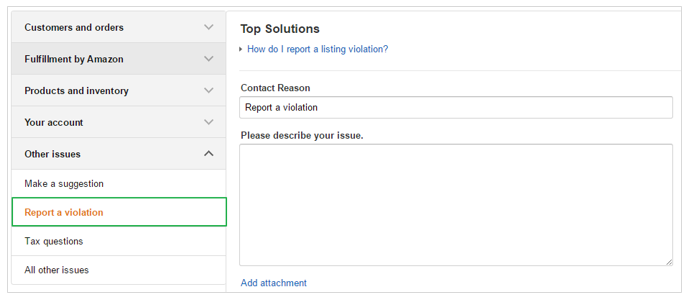
A. The “condition” here only applies to whether the product was used by a customer. If you think about it from a distributors point of view (the distributor buys it from a manufacturer and resells it) then that product is not used, it’s still new. If it’s an unauthorized reseller – but it’s still a legitimate product then that’s not necessarily something that Amazon is going to actively police. (See Part 3: MAP violations below).
A. No, but the used/refurbished offers will not compete against offers with a condition of “New” for the Buy Box.
A. That’s a great question – but essentially the answer is no, you can’t. Amazon allows for as many sellers to sell on the marketplace as possible – as long as they adhere to Amazon’s policies. The more sellers – typically the more competition. The more competition means better prices, and better prices typically means a better buying experience – which leads to more customers returning to the marketplace.
A. Go to the product’s detail page. Look at the section on “Ship and Sold By”. There you will find the seller’s name. Once you click on the seller’s name you will see their “Seller Information” page (see below). You can ask a question directly (located in the right corner) and send them a message.
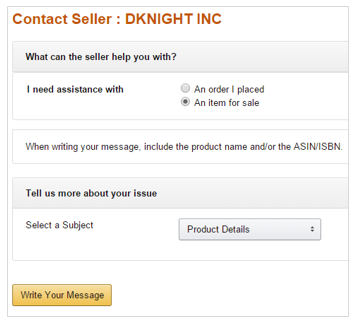
To request removal, brand manufacturers can reach out with a cease and desist letter. This is the most effective if perceived to be coming from a lawyer. The goal is to create the perception of risk for the violating seller. Although this might not necessarily have legal teeth – it is a scare tactic that will work to get sellers to leave that detail page.
A. Place a test order then contact Amazon referencing the order (see below).
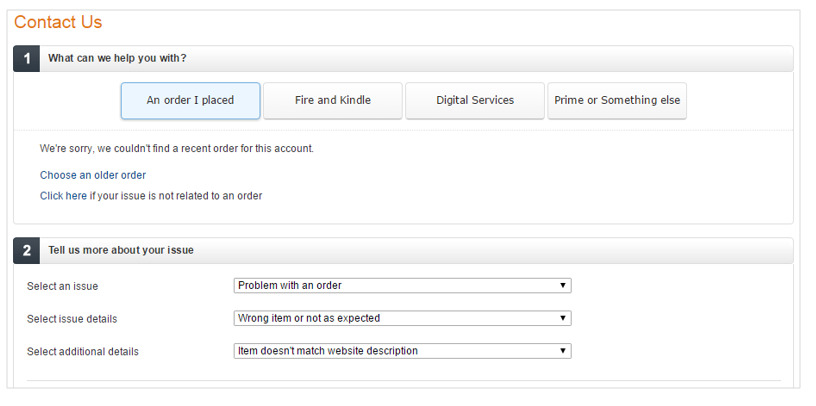
A. As a manufacturer, your network of wholesalers, distributors, and resellers directly impacts what shows up on Amazon. Include restrictions in your distribution agreements to prohibit resellers from selling on Amazon.com.
When possible, adjust your wholesale prices to make it financially untenable for resellers to profitably undercut your price on Amazon. Include serialization on your products for tracking and be mindful that brand policing on Amazon is not a quick fix, but an ongoing effort.
A. Yes, sellers are free to set their own prices.
A. Either will work. The contact us page is from your buyer account and is therefore easier to reference a test buy order ID with.
A. Yes, via seller information (see above.) “Companies such as ThornCrest also work directly with Amazon’s legal department to shorten the A-to-Z process.
A. You should group all of the ASINs into one message to create the perception that your legal team has analyzed their entire catalog and identified multiple violations. The goal with the cease and desist letters is to create the perception of risk, and the greater the risk you can create for the violating seller, the better.
A. If a separate product detail page is being created on Amazon for the new product, this is not considered counterfeit and is not a violation of Amazon’s policies. You would need to enforce this directly with your manufacturing facility.
A. Sellers will be removed for counterfeit listings. If one seller is listing multiple counterfeit products, that seller and all of their offers will be removed. However, if each listing has multiple different sellers, then you will need to create a test buy to remove each seller’s offer.
A. While it is time consuming, test buys are the only way to successfully remove counterfeit offers on Amazon. As a buyer, you can also request a refund or submit an A-to-Z claim to ensure you are reimbursed for the purchase. You can also consider messaging the seller directly first, before making a test buy, try to scare them off of the detail page. Keep in mind that Amazon will only remove one seller that is found to be offering counterfeit listings. If there are many sellers, you would need to test buy for each seller.
A. There is no way for another seller to just pull your list of products, but what is likely happening is these resellers are getting your product from somewhere (not necessarily from Amazon) and are reselling it on all of these marketplaces. It’s the brands responsibility to have airtight agreements and to monitor those agreements.
A. While it shouldn’t matter which portal you submit the violation through, we do tend to get quicker responses through Vendor Central support cases.
A. You might want to consider using Labeled inventory for your FBA offers to prevent having your authentic inventory from being pooled together with counterfeit inventory. Also, if this is an unauthorized seller of authentic product as opposed to counterfeit product, you may want to look at your distributor network to identify where the products are originating from.
A. Yes, you can both comment on a review so that future shoppers can see publicly that the original reviewer is referring to a counterfeit product and you can also report the review to try to get it removed (see below).

A. Amazon does not adhere to MAP and has full control over the price of the inventory they purchase from Vendors. A vendor can adjust the wholesale price they sell to Amazon at, but not the final sale price to customers.
A. MAP (Minimum Advertised Price): Some manufacturers dictate that resellers cannot show an advertised price under a certain amount for their product. The selling price for your product will not be displayed on the product detail page or offer listing page if it is less than the minimum advertised price.
Pro-Tip: For more on MAP, check out “Minimum Advertised Price (MAP) Violations & Policing Your Brand on Amazon“
A. No. A seller can use MAP to set the minimum price for themselves but not for other sellers (see below). Amazon doesn’t like MAP – and we imagine if they could do away with it they would. They want more competition, lowest prices and better buying experience for shoppers.
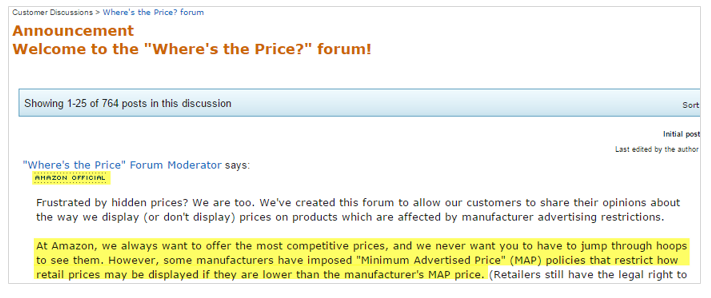
A. Yes. A few examples of services include Brand Protection Agency, Brand Shield, and Wiser. These work not just on Amazon, but to monitor your brand across the web for unauthorized resellers, counterfeit products and for MAP.
Pro-Tip: It’s important to note there is a difference between identifying unauthorized resellers / counterfeit items and actually doing something about it. Identification and monitoring is first and then brands will have to take steps to enforce those policies. Unfortunately, it’s not a one stop shop.
A. While unauthorized resellers might not answer you on Amazon (because they are not violating anything on Amazon) they are still violating a legal distribution agreement that you have with them. One of the things you might want to do is to place a test buy (even with the understanding that the product is legitimate) to see if you can learn who the actual seller is because you might not be able to tell by their 3P seller name on Amazon. Then, using that information – you can reach out to them with a cease and desist letter that actually does have legal teeth.
You can also use product serialization to try to identify who is violating those MAP agreements. It’s important to remember distributors are not going to enforce MAP for you. A good technique is to pre-authorize every single retailer through an “authorized retailer agreement”. Then you have an agreement with that retailer. From a financial standpoint, it doesn’t make sense to sue somebody for breaching MAP (not enough ROI) considering the cost of the litigation. Our solution is to, stop selling to them and let them sell through what they have left. Run them dry.
A. The enforcement of distribution agreements is the responsibility of the brand manufacturer and not something Amazon will get involved with. Raising prices to your wholesalers and distributors is another way to make it financially unfeasible for them to continue selling at a price which undercuts your Buy Box price.
A. Amazon does not adhere to MAP and has full control over the price of the inventory they purchase from Vendors. A vendor can adjust the wholesale price they sell to Amazon at, but not the final sale price to customers.
A. If they have the legal authority to represent in the US, they can certainly put agreements together (assuming they have agreements with their distribution houses). Typically though, MAP is not a term used in most parts of the world because they consider it price fixing.
For additional information, email [email protected]
A. No, as long as your messages don’t include abusive or inappropriate language.
A. The Amazon Brand Registry enables you to:
Influence the product detail information for your branded products: As the registered brand owner, the information you submit to the product detail pages for your registered branded products is displayed automatically, which then helps you to specify the correct titles, details, images, and other attributes for your branded products.
List products without UPCs or EANs: Registering your brand enables you to specify an alternative key attribute that you can use to list your branded products instead of a standard product ID.
A. Enrolling a brand in the Brand Registry and registering as the brand owner does not prevent other sellers from selling the branded products.
A. The submission form (as seen below) can be found in Seller Central.
Pro-Tip: For more on the Amazon Brand Registry application check out “What is the Amazon Brand Registry?”
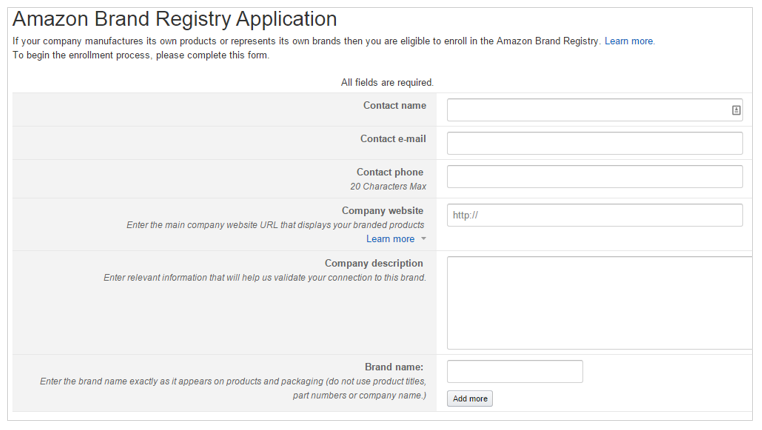
A. It’s the brand’s responsibility to enforce their agreements – Brand Registry is mostly just for content authority.
A. Within Seller Central, in business reports, there is a performance report that you can download to see which ASINs and SKUs have been successfully enrolled.
You will also get back the Global Trade Identification Number (GTIN). Amazon assigns a GTIN to each product.
Also within, Manage Your Inventory – you can find a specific child ASIN, click on edit and at the top of the page – it will say “this product is enrolled in the brand registry program” and it will give you the unique product identifier you used to enroll it.
A. Brand Registry has no impact on combating counterfeit products. You will have to make a test buy and prove the product is different than what is listed on the detail page.
A. The content submitted by vendors is weighted more heavily than content submitted by third party sellers registered in Brand Registry. As a result, the vendor submitted content is what will show on the detail page. From a practical standpoint, only the brand manufacturer can be a vendor and a 3P in the Brand Registry program, so it would be two different channels from the same seller.
A. These terms are in relation to sellers creating additional variations to existing parent/child groupings. Brand Registry allows for content authority for brand manufacturers but does not provide any protection against the creation of new variations.
A. No. Only the brand manufacturer (Bose in this case – see example below) or authorized distributors with explicit permission from the manufacturer can be vendors to Amazon.
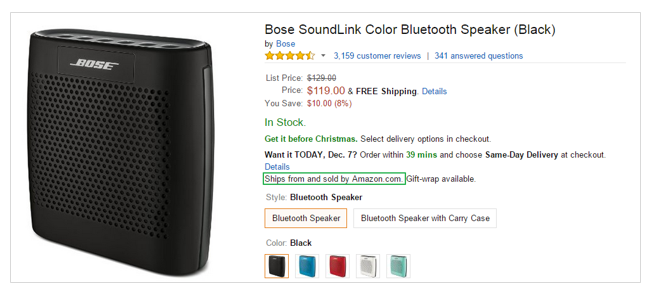
A. Research shows that duplicate listings caused by missing or invalid UPCs make it more difficult for customers to find, evaluate, and purchase products. To improve the customer experience, starting on February 19, 2014, [Amazon] will require a valid UPC (or other Standard Product ID) for new and existing listings of designated brands in all categories.
A. Amazon has actually made this very easy. Within Vendor Central you can open a support case, select manage my catalog, select duplicates and at the bottom you can describe the issue (as seen below) in the merge ASIN form.
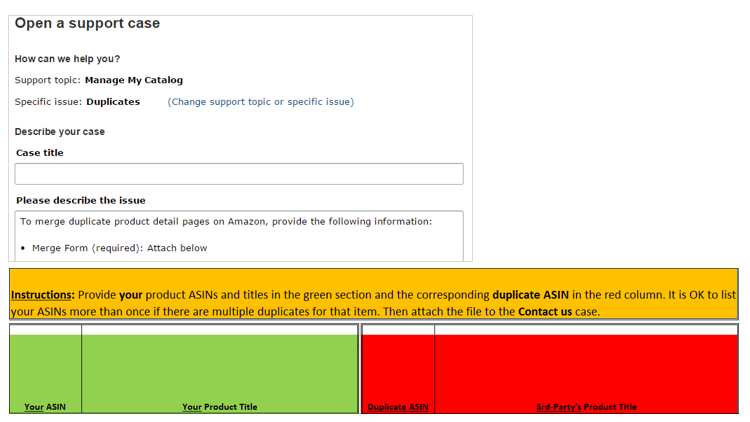
When you submit this information, Amazon will roll them up and put the duplicates beneath as offers on your ASIN. So, instead of somebody seeing these 5 different ASINs (on the SERP), they will only see the one listing and all other 3P listing will be behind you.
A. Amazon is interested in conversions and a good buying experience. They don’t necessarily care if you sell a product at a loss. So, it’s identifying – who is that reseller and how are they able to drive the price down? Nobody is going to continue to drive a price down if they are losing money.
What we have seen – is the product is typically a counterfeit. Genuine products still need to cover the cost (even if they acquired it through liquidation). Generally though, this situation is an indication of a counterfeiting problem.
A. It is difficult to establish a relationship with Amazon’s legal department, but there are select services that can provide assistance. For more information, email [email protected]
As explained in the webinar, Amazon does not abide by MAP. Amazon is competing for the Buy Box, so it will lower its prices in order to get the sale. Amazon lowers its prices to compete with the other sellers. Accordingly, if there are other sellers on Amazon that are not abiding by MAP, then Amazon will lower its prices to be competitive. If no one is selling below MAP, then Amazon will keep its prices high too — it may drop its price to a dollar below MAP, but really won’t go crazy.
A. Your 3 options would be to:
1) Terminate your relationship with them & have your distributor stop selling to Amazon
2) Accept that they won’t adhere to it, or
3) To sell on Amazon as a 3rd party (instead of a distributor selling your products to them, you’d sell on Amazon directly to the consumer) in which case you can set whatever price you want since you’d be the seller.
Policing Your Brand on Amazon: Copyright & Trademark Infringement
